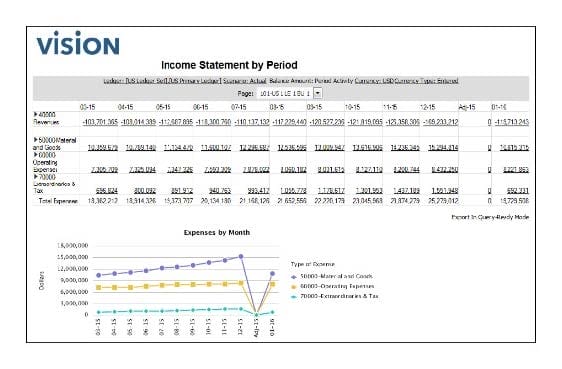Exam Details
Exam Code
:1Z0-982Exam Name
:Oracle Enterprise Planning and Budgeting Cloud Service 2017 Implementation EssentialsCertification
:Oracle CertificationsVendor
:OracleTotal Questions
:93 Q&AsLast Updated
:Mar 25, 2025
Oracle Oracle Certifications 1Z0-982 Questions & Answers
-
Question 51:
What are two use cases for converting from Planning and Budgeting Cloud (PBCS) to Enterprise Planning and Budgeting Cloud (EPBCS)? (Choose two.)
A. The ability to directly integrate with Enterprise Performance Reporting Cloud (EPRCS).
B. The ability to leverage out of the box frameworks, like Financials and Projects.
C. The ability to utilize a fully integrated application, with shared metadata and direct data flows between plan types.
D. The ability to use Data Management.
E. The ability to directly integrate with on-premise Hyperion Planning.
-
Question 52:
Which two dimensions are displayed on the user point of view bar within a Financial Report? (Choose two.)
A. Dimension tagged as Time
B. Dimension tagged as Account
C. Dimensions in a row, column, or page that are flagged for the current point of view
D. Dimensions are not currently defined in a row, column, or page
-
Question 53:
Which two operations can be performed on the default navigation flow? (Choose two.)
A. It can be copied.
B. It can be renamed.
C. It can be deleted.
D. It can be deactivated.
-
Question 54:
Which two options are true when implementing security in Enterprise Planning and Budgeting Cloud (ePBCS)? (Choose two.)
A. Users are restricted from applications by removing application/module security
B. ePBCS roles can be assigned to members in all dimensions
C. The member that is set to read that has a parent with write access to all descendants will result in an access level of read
D. A user that is assigned read and write access to a member will result in write access
-
Question 55:
What Enterprise Planning and Budgeting Cloud (EPBCS) card in the Application cluster was built to navigate administrators through maintenance activities?
A. Data Maps
B. Overview
C. Settings
D. Valid Intersections
E. Configure
-
Question 56:
Which three are Enterprise Planning and Budgeting Cloud (EPBCS) features that can be used to help streamline the amount of time a user spends in a web form? (Choose three.)
A. Valid intersections
B. Hide dimension name
C. Action menus
D. User variables
E. Workflow
-
Question 57:
Which item lists the available types of mapping in Data Management?
A. Explicit, Range, In, MultiDim, As
B. Explicit, Between, In, MultiDim, Like
C. Explicit, Range, In, Ignore, Like
D. Explicit, Range, In, MultiDim, Like
-
Question 58:
Where would you navigate in Data Management to map source data to target scenarios?
A. Category Mapping
B. Target Application
C. Import Format
D. Data Flow Mapping
-
Question 59:
If a user is having trouble accessing a specific intersection of data on a form that opens without error, which three actions can an administrator take to help troubleshoot the problem? (Choose three.)
A. Run a system report on Access Control
B. Confirm the user's/group's dimension access rights
C. Set Dimension Administration auditing within System Reports
D. Run Application Diagnostics
-
Question 60:
If a user has been granted access to multiple navigation flows, how can they switch between them?
A. By clicking the navigator bar, then updating their variables
B. By clicking the navigator bar, then the down arrow next to the title of the navigator flow
C. By clicking the navigator bar, then updating their preferences
D. By logging, then signing in as a different user
Related Exams:
1Z0-020
Oracle8i: New Features for Administrators1Z0-023
Architecture and Administration1Z0-024
Performance Tuning1Z0-025
Backup and Recovery1Z0-026
Network Administration1Z0-034
Upgrade Oracle9i/10g OCA to Oracle Database OCP1Z0-036
Managing Oracle9i on Linux1Z0-041
Oracle Database 10g: DBA Assessment1Z0-052
Oracle Database 11g: Administration Workshop I1Z0-053
Oracle Database 11g: Administration II
Tips on How to Prepare for the Exams
Nowadays, the certification exams become more and more important and required by more and more enterprises when applying for a job. But how to prepare for the exam effectively? How to prepare for the exam in a short time with less efforts? How to get a ideal result and how to find the most reliable resources? Here on Vcedump.com, you will find all the answers. Vcedump.com provide not only Oracle exam questions, answers and explanations but also complete assistance on your exam preparation and certification application. If you are confused on your 1Z0-982 exam preparations and Oracle certification application, do not hesitate to visit our Vcedump.com to find your solutions here.
